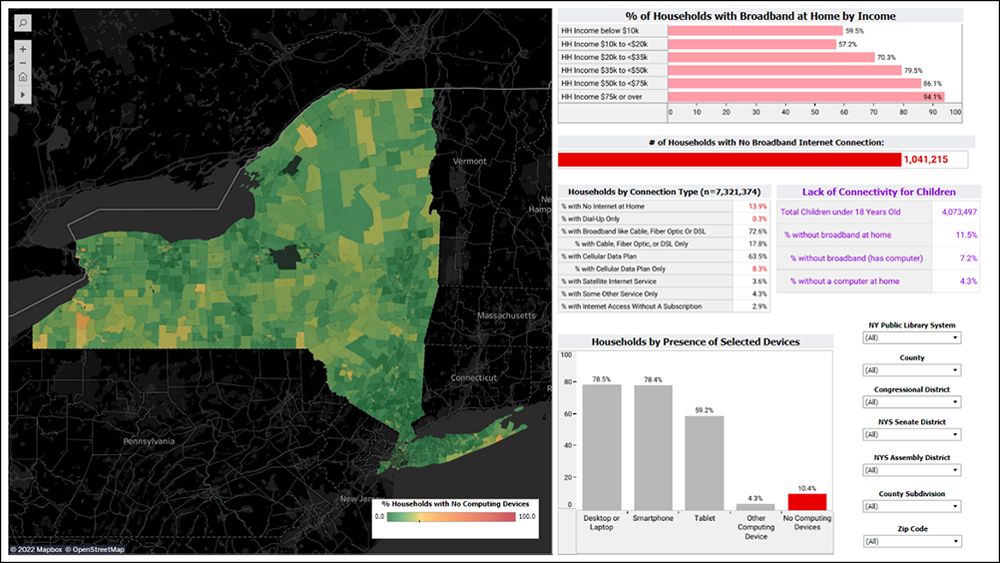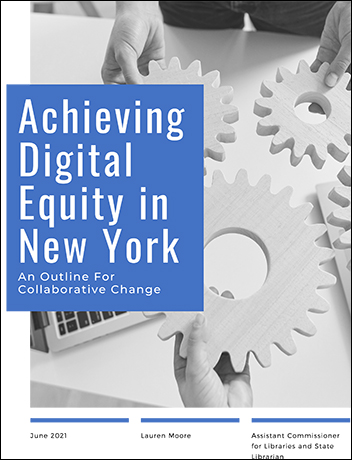Grant Spotlight | October 31, 2022
Share ThisOctober 31, 2022
“With reliable data and information, library staff can bring individuals and organizations together to develop strategies, programs, and services that will help New Yorkers of all ages access the devices, connections, and digital literacy skills and knowledge needed for success in the 21st century.” — Lauren Moore, Assistant Commissioner for Libraries and New York State Librarian, New York State Library

There is no doubt that in modern society, being connected digitally makes an enormous difference in how people live their lives. Digital tools and platforms are how people today schedule doctor’s appointments, apply for jobs, pursue educational endeavors, and carry out a range of other activities. But not everyone has the same access to or ability to pay for digital connections, which provides a significant opportunity for community stewards such as libraries to bridge the gap. The New York State Library is one of these community leaders working to achieve digital equity.
Thanks to federal CARES Act stimulus funds from the Institute of Museum and Library Services, the library fulfilled its goal of providing state-level leadership, planning, coordination, consultation, and support services to advance digital equity and inclusion efforts that improve broadband adoption.
“Libraries play such important roles in creating, curating, and disseminating reliable information about digital equity issues and the digital inclusion challenges facing local communities,” says Lauren Moore, Assistant Commissioner for Libraries and New York State Librarian, New York State Library.
The first step in this multi-pronged endeavor included planning a series of Digital Equity Summits, which meant partnering with government, nonprofit, and private organizations working in digital equity across New York.
The summits led to a report, “Achieving Digital Equity in New York: An Outline for Collaborative Change,” which provides a roadmap to guide the library’s future digital equity work.
In the next phase, Moore and her team at New York State Library reviewed feedback from the summits and engaged outside experts to create customized research-based information resources to help New York’s libraries, library systems, partner organizations, and stakeholders better assess digital equity needs at regional and local levels. Out of this came another report, “New York’s Digital Divide: Examining adoption of internet and computers for the state and its library districts.”

“We also developed the NYS Digital Equity Portal, an interactive online data and mapping tool for New York State communities that want to advance digital equity,” Moore explained. “These tools have proven to be invaluable in planning and obtaining support for digital equity work throughout the state.”
Finally, the team coordinated a series of Digital Inclusion Webinars for practitioners and engaged a technology expert to conduct a broadband infrastructure needs and technology assessment pilot project for public libraries.
Laying the Groundwork
The problem of digital inequity—especially at the start of the pandemic—seemed immense.
“At times it felt overwhelming to look at a problem of that scale and then identify the ways we could make a meaningful difference. We realized that digital inequity was not a problem the State Library or even libraries as a whole could solve on their own,” Moore said. “In the end, we focused on projects that built capacity and promoted partnerships.”
Moore and her team at New York State Library knew their project would serve as the first steps on a long road; digital equity initiatives in New York are continuing to evolve and gain traction, so the project team is always developing and expanding digital equity projects and programs.
“We worked hard to make sure that equity was both a driver and outcome of our Digital Equity Summits and our Digital Inclusion Webinars,” Moore said. “We sought representatives from and advocates for traditionally marginalized and excluded communities and brought the concept of racial justice to the forefront.”
Throughout the project, the library forged important connections with state agencies and various digital equity practitioners across the country.
Envisioning an Equitable Future
New York State Library plans to continue with the next phase of the broadband infrastructure needs assessment project, which will include additional libraries and regional library systems. This project will include an assessment of the participating libraries’ technology and address specific ways that they can improve.
“We’re also working in collaboration with a partner to develop and implement New York State’s Digital Equity Plan,” Moore said. “We’re doing the bulk of this work through our Digital Equity Working Group, which was formed earlier this year.”
About the Project
Grant Project Name: CARES-Digital Inclusion
Grant Log Number: 2020-NY-85614
Year Awarded: 2020
Recipient: New York State Library
Project Contact:
Lauren Moore
Assistant Commissioner for Libraries and a New York State Librarian
New York State Library
518-474-5930
Lauren.Moore@nysed.gov
Website: https://www.nysl.nysed.gov/
